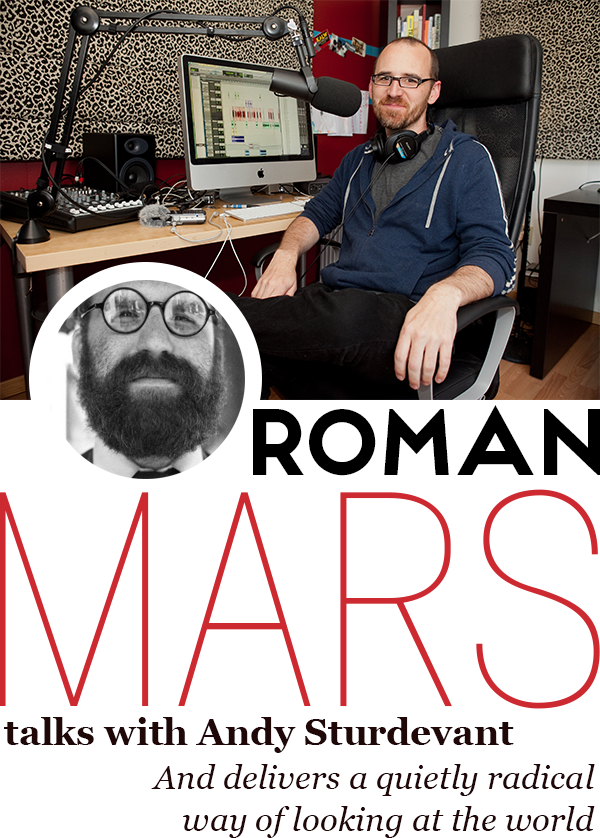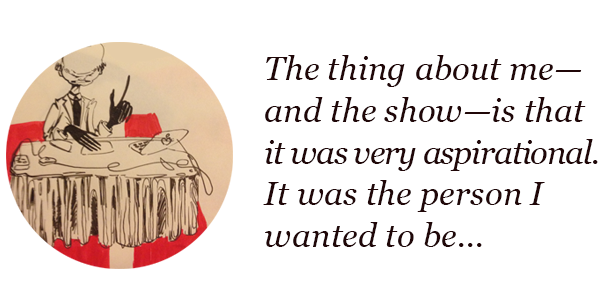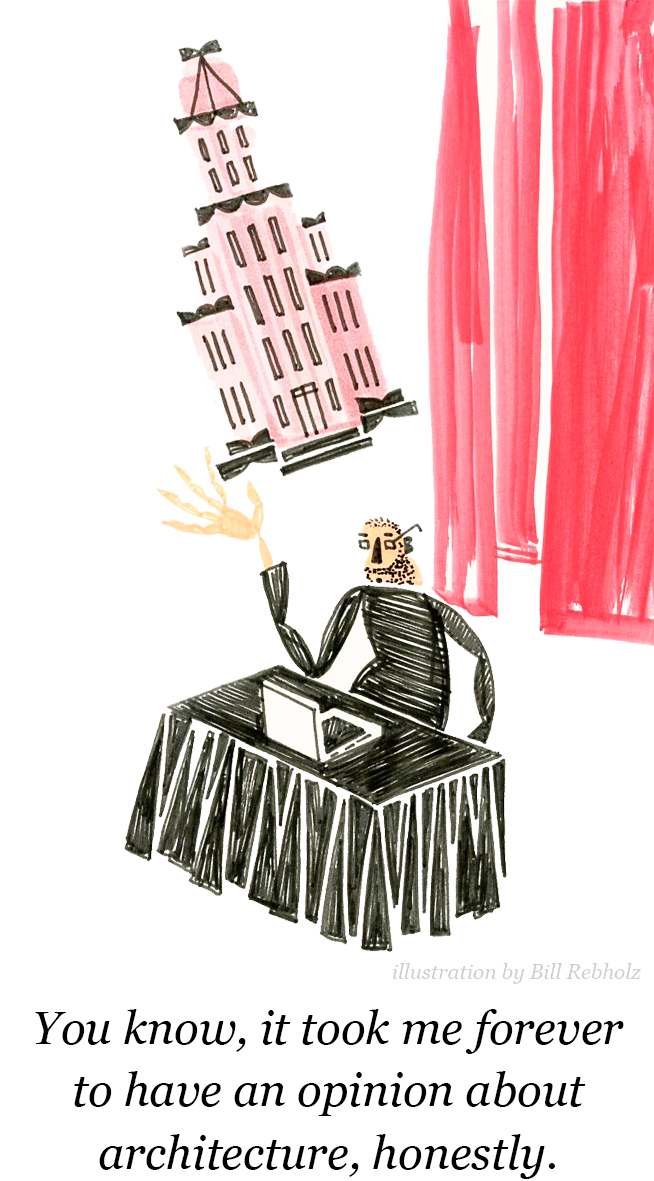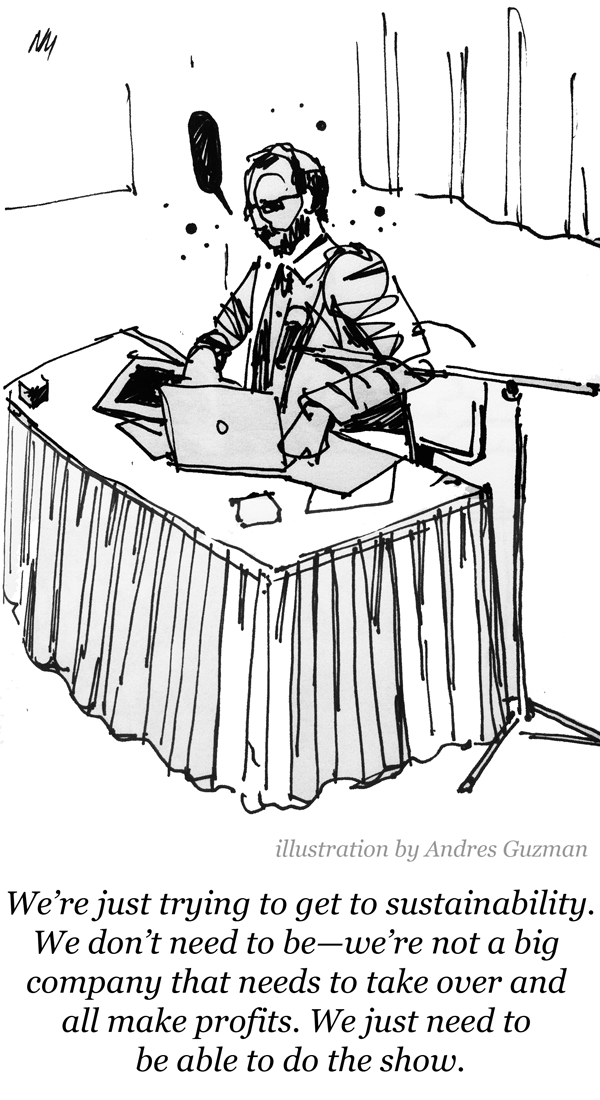Roman Mars is the creator and host of 99% Invisible, a fantastic weekly podcast about architecture and design that covers so much more ground than that modest description would suggest. On the show, Mars presents a quietly radical way of looking at the world. Over the course of a dozen or so minutes, he uncovers and tells the stories of why the everyday things that surround us—office buildings, bar codes on grocery items, revolving doors, re-purposed Pizza Huts, city flags—look and function the way they do.
A presenter at the recent OTA conference in Sioux Falls, South Dakota, Mars took to the stage to talk about the show, perform a few live renditions of favorite past episodes, and ask why Sioux Falls (unlike Chicago, Washington, D.C. or St. Louis, among others) doesn’t have its own city flag. Based on the excited chatter I heard among designers, teachers, and students after his presentation in the lobby, someone in Sioux Falls is going to have the flag problem figured out by the next time Roman Mars is in the South Dakota. He seems to have that effect on people.
Mars and I sat down in a nearly empty cafeteria following lunch, right by the South Dakota Music Hall of Fame, for a conversation about balancing creative work with more mundane tasks, directly connecting creative people with an audience for their work, and how a certain well-known Washington D.C.-based punk label has been a guiding light for the independent radio network he’s helped create.
Andy Sturdevant: You perceive the world in a very specific way. You have a good eye for details, and for drawing out these stories that are embedded in the physical environment. I don’t know if that that’s something people are born with. I mean, some people may have that skill innately, but I think it’s something that you develop over time.
Roman Mars: Oh, it’s total development to me. The thing about me—and the show—is that it was very aspirational. It was the person I wanted to be, not the person that I necessarily was. And it isn’t even the person I am all the time. Like I can walk past a plaque very callously. But I’d like to be that person that I am when—I don’t mean to be arrogant and talk about myself in the third person, but—
AS: No, go for it!
RM: It is very aspirational, in the way I want to be. The lens of viewing the world through99% Invisible is, I think, a pretty optimistic lens. It’s people solving problems. Even in their failures, there’s something in that failing. And so I had to become that person who pays attention, because I’m very easily too preoccupied with my own thoughts, or too closed off in my iTunes. I listen to stuff all the time, and so I’m totally the type of person that would not talk to people if it wasn’t my job to talk to people.
AS: Oh, interesting.
RM: I’ve kind of oriented my life to deal with my own weaknesses. So for those aspects of my life—like where I was the type of guy to go on architecture tours, I was the type of guy to notice and love these certain things and to love details, turning those into an everyday practice took effort. It was not natural.
AS: So was there a specific moment or place in the world where it went off for you that the physical environment, the built environment, is something that’s worth paying attention to?
RM: You know, it took me forever to have an opinion about architecture, honestly. I viewed architecture—and I think most people view architecture this way—like you view mountains. You know that they’re beautiful, but you don’t really think you should or could have an opinion about them. They’re just kind of there. I was the same way for a long, long time until—and this actually was one of the life-changing things—when I was just about 30 years old, and I moved to Chicago. They had that architecture boat tour.
AS: Right, where you go down the river in the boat, and they tell the stories behind all the buildings you’re seeing.
RM: Yeah. I went on it, and it just settled into me. I realized you could tell these stories the way I was used to. I was already in radio, and I thought, “You could tell these storieswithout the visuals, and they would work.” And that was what locked it in for me, because I’m not a supremely visual person, quite honestly. I like auditory stories much more. I like stories of things. I kind of don’t have a strong opinion about a lot of visual things. I’m totally story-biased, story-driven, and usually that’s your entrance into architecture, where you begin to love something or hate something. That’s your entry. And I didn’t have those very strong opinions. It happened late for me, and it probably didn’t like codify until, for example, the boat tour, and coming to the Montgomery Ward complex [along the Chicago River] and seeing this building I did not care about and realizing, oh, yeah, that is a kind of amazing building in its way. It’s not very memorable initially, but if you roll back history and you see it in that context, as something so utilitarian, so free of ornament and like fussiness and stupid crap, you can see that it was revolutionary.
AS: And that’s the story that makes the building interesting. But in order to tell that story on the 99% Invisible episode about the Montgomery Ward building, you brought in an architectural historian to help. Another thing I really like about the show is you’re not necessarily the authority.
RM: I’m never the authority.
AS: Right. You bring in other people. Which is great, because it makes you a proxy for the listener.
RM: That’s my job. I think of it as a column about design on the radio. So it’s fact-based, it’s story-based, but it definitely comes from a point of view. You can say, “Fuck you, Chrysler,” [as Roman did in 99% Invisible’s episode 100, “Higher and Higher,” about the design of the Chrysler Building and Walter Chrysler’s failure to properly compensate his architect] and get away with it. That’s something you can’t do in a reported story.
AS: No, of course not.
RM: And so there’s that sense that the show has a point of view. I’ll definitely have an opinion, and that opinion comes up through reporting the work, through working with a reporter to turn it into something. Often when I green-light something that a reporter brings to me, it’s because I’m like, “I’ve been thinking about this. I have a little bit something to say about that.” And it gives me a chance to do it. So there’s a little bit of an opinion, but there’s also very little authority from me. It is about a normal person’s reaction to the world and experiencing the world and maybe just a little more aware than average, but just to make it so that we’re all in it together. Like we’re all looking at things together and appreciating things together. It’s saying, you’re not a weirdo for really loving sewer grates and how they function and loving a little design flourish. Often my job in the show is to provide the sort of geeky enthusiasm for a thing to get people past the initial problem of these seeming like just mundane things. Because initially, people can be closed off. It’s just like, “I don’t care about doorknobs.” And you say, “No, but, really, these door knobs.” And that’s your job, is just to be that proxy.
AS: Your work with the show has led to some larger scale projects, like [independent radio network] Radiotopia, which have had some real success. But 99% Invisible started pretty small, pretty independent, pretty scrappy.
RM: Completely, as small as you can get: one person, a four-minute show, released semi-regularly.
AS: Yeah. And what’s it been like building that from the ground up? Has it been a really intentional process, or is it something where you just make it up as you go along? Sometimes when you’re building these things, it’s a very reactive kind of process. You just deal with things as they come.
RM: I mean, I think it has to be a combination of intent and just getting the lay of the land and how things are going. No one’s more surprised at the success of this show than I am. Well, that’s not exactly true. I didn’t know if the show would be successful, but I made the show to be successful. Like I knew what I wanted out of it. When I was thinking about a show about architecture and design, there were already a lot of people out there talking to architects. They were talking about the creative process and stuff like that, but I didn’t see anyone taking a really story-based approach to the work. And so I was like, well, I could work in that space in a way that’s very intentional. I noticed the world orienting towards the idea of design in the broader scope of what design was, and I could see a place for being sort of a weird advocate in the design world. Early on, a person told me about the show: “You know how Neil deGrasse Tyson is not an astronaut, but he advocates for NASA? That’s kind of how I see you. You’re just out there and saying, ‘Hey, architects, go for it. Designers, all right. We’re on your side.’” And that would be a great role. There are a lot of good people doing interesting work. Let’s talk about it. It’s fun. And so I like that it’s taken off in these ways. I like that it’s grown. The show is better than ever, because we have a staff of people who are super-talented.
AS: Yeah. And you’ve all found a way to fund it consistently as it’s grown.
RM: Right. No one had really had a success that was adjacent to public radio, but not really through public radio. And then so we created this path, and I wanted to pave the path so that other people who are my friends who I came up with in radio—you know, they can’t do hour-long, weekly shows that are on the radio, because stations don’t want it, or it’s too weird. But I knew an audience would care. And so once we had established this path, I was wondering if we could we turn this into a business plan for other people. And that’s what Radiotopia is about. It’s taking the lessons that I had to fight through to make99% Invisible successful and then impart that to the crew, the Radiotopia group, and then use my platform to help get them launched. Because I was the beneficiary of that. If it weren’t for Jad Abumrad putting me on Radiolab, my show would not be successful.
AS: Sure.
RM: I was on that show, and it launched us in earnest. So I want to do that for other people. I want to just give them a path to success so that people who are the most talented weren’t being discouraged from being in public media. This idea of Radiotopia is something I’ve been pursuing forever, beyond actual common sense. But it’s important. It’s important to me.
“Once we had established this path I was wondering if we could turn this into a business plan for other people. And that’s what Radiotopia is about.”
AS: Well, I love that you mentioned The Clash and Black Flag in your presentation this morning, because there seems to be something really resonant there as far as the way that those bands in particular made their careers.
RM: Absolutely.
AS: They carved out a path, and cultivated an audience where there hadn’t necessarily been one organized before, and then they encouraged other like-minded groups and people to follow along in the wake of what they’d created.
RM: It’s true. Black Flag formed [their record label] SST around those people. They really tried. I don’t want to particularly sound very angry about this, in a way, but I never want to be dependent on other people telling me “yes” for me to do my job. And now that I’ve gotten past that point, where it takes a thousand people to fire me, the hard part is that it takes a thousand people to hire you, too.
AS: Right.
RM: But I’d rather have that than the alternative. I’d rather have that than have someone who, like lots of people I know, has been at NPR for decades and then just gets fired or let go, and then don’t have direct access to the audience, because they’ve always been mediated through this other source. And they don’t control things. And that’s just not the future of media. The future of media is you have direct access to the people, and those people support you, and that’s what makes it work. And so I want to introduce these folks in such a way that they’re not mediated through these other sources. You have to set your own value. The Kickstarter campaign and various other things we tried were about setting our own value, deciding this is what we think we should do in order to do the show and do it well. Our last campaign was all about getting our staff healthcare. I’m not going to fight the people who control things anymore. I’d rather just ask the audience for what’s right. It’s kind of the punk rock label I never got to start.
AS: Right, like what you were saying about Black Flag and SST.
RM: Exactly. I’ve always wanted to have my label. My favorite was [Washington, D.C.-based independent punk label] Dischord Records. Like I bought every Dischord record. To me, it was like I wanted an indie label. And so in a way, PRX [Public Radio Exchange] runs the label, and I get to curate it. But I’m basically a member, and it’s fantastic. I mean, it’s what I wanted the world to be like, and I hope we can make it work. It’s still an experiment. But I think ultimately it’s going to be worth it. I’m hopeful.
AS: Yeah, obviously, there’s the creative component of your work, where you make the shows, but there’s also this administrative aspect where you have to, I would imagine, fundraise and answer emails and—
RM: Oh, it’s so much a part of my job now.
AS: Well, how do you balance the creative with the administrative? That can be really difficult.
RM: It’s super-hard. I can’t let go of the parts of the show that I really love. With every episode, I spend two days with it working on it, doing the narration, stuff like that. If that ever went away for good, I would lose my mind. It’s my real joy.
AS: Sure.
RM: But you also get texts and emails all day long, and my job could just be emailing if I allowed it to be. But I would never complain about it, because it’s such an honor that people care. Most of my life people have not cared. But more of my job is not making radio these days, which is, you know, it’s mixed. I have to make sure that we’re all employed and we all have jobs. So I have to do phone calls with sponsors. Or do trips around the country to add to the budget and things like that. But it’s okay. It’s a part of the whole. Fundamentally I’m a producer, and more than a journalist, and I make the show happen. And so that involves problem-solving in every aspect, and part of the problem is financing, and so the Kickstarter campaigns were about solving that problem. And you have to learn to love it, because it’s your job no matter what. It’s like, get used to it, because the new job is like being your marketer and your fundraiser, and it’s like every media entity is going to have to do that these days. And I just happen to kind of like it. I mean, I didn’t think I would be any good at it.
“…And you have to learn it because it’s your job no matter what.”
AS: But you seem very comfortable with it. And very good at it, for that matter.
RM: Well, I was like, oh, it’s basically like producing a show. You solve problems, you make decisions, you try to make things pleasing. Like a funding campaign follows a narrative path. You know, you can make it fun and you can bring joy to it, and then people want to join it. And so I’ve enjoyed it. I think I just want to try things and just make sure that we’re all employed, make sure we’re all are doing okay, and we can tell the stories we want to tell. That’s all I want. It doesn’t need to take over the world.
AS: Sure.
RM: We’re just trying to get to sustainability. We don’t need to be—we’re not a big company that needs to take over and all make profits. We just need to be able to do the show.
AS: I’m glad you mentioned Dischord Records, because the more you talk, the more it really sounds like that’s a good model for this work.
RM: Totally. It totally is.
AS: Dischord never became like Capitol Records. There isn’t a 13-story Dischord Records Towers in downtown Washington, D.C.
RM: But [Dischord founder and Fugazi frontman] Ian [MacKaye] makes a good living. They bought the houses that Dischord was based out of, and everyone got paid. But like there’s no intention—like if we’re the Fugazi of radio, I would love that position, just so you could keep touring, keep ticket prices low. And as long as everyone can take care of their kids and stuff, that’s all that really matters. It doesn’t need to be huge. If everyone just gets by and we do the show, we could keep going like that. And when we get bored, we just decide to do something else! We just do the next show. I’ve got a million ideas for shows. 99% Invisible is something that I think can last. I’d like it to last. I’m not eager to leave it. But it’s like, no one thing is that big a deal. It’s the people that are involved that really matter.
This interview has been edited for length and clarity. Many thanks to Paula Burns at Burn Transcription Service in St. Paul.
Interview By Andy Sturdevant
Illustrations by Andres Guzman, Bill Rebholz, and Feng Meng Vue. All illustrations were created during a live preformance by Roman Mars at OTA14:Sioux Falls.




